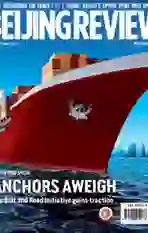TIME TO GET ON THE ROAD
2017-05-27ByMichaelZakkour
By+Michael+Zakkour
This month, China will host high-ranking political and business leaders from all over the world to participate in the Belt and Road Forum for International Cooperation, which may be the most important diplomatic and business conference of the year in China. Yet, many in the West still are not aware of or do not fully understand what the Belt and Road Initiative is and what the opportunities for participating in and profi ting from it are.
At present 28 heads of state and government will be attending, but only a handful from Europe and only one from a G7 country, Italys Prime Minister Paolo Gentiloni, are set to attend. This is telling. For more than two years I have been writing and speaking about the importance of the Belt and Road Initiative and the ways in which it may shape the future of global trade, regional and inter-regional relations, global consumption, energy use and solutions, and logistics and transportation in the coming decades of the 21st century. Yet, for many in the West especially in the U.S., the opportunities it will create are still a backburner issue, if on the stove at all.
What is the initiative?
The projects full name is the Silk Road Economic Belt and the 21st-Century Maritime Silk Road.
The name and the forthcoming reality of the project harken back to two key historical eras, both of which had China at their core. In order to understand the thinking behind and the potential impact of this massive endeavor(as with most things China-related), you must understand the history behind it as well as its interpretations.
The fi rst historical precedent is the original Silk Road. For almost 1,500 years, the Silk Road connected China with the West through a series of land-based trade routes that spanned almost all of China, India, East Asia, Central Asia, the Middle East and Europe.
It was the fi rst true manifestation of globalization and the fi rst iteration of the information superhighway. Products, ideas, cultures, and religions were transported from east to west and on a somewhat smaller scale from west to east. Spices, silks, horses, weaponry, teas, gunpowder, paper, and the compass were moved from China westward through a series of trade routes that incorporated dozens of countries and thousands of producers, buyers, sellers, traders and bankers.
The system was in place through the 16th century.
The Silk Road played a signifi cant role not only in trade but in the development of cultures, kingdoms and nation states from Japan in the east to Eastern Europe in the west and India in the south.
The Silk Road also had a maritime element. Products and ideas were moved not only on land, but also by sea. Trade routes from China moved south to Indonesia and Southeast Asia, and west to India, the Gulf region, the Arabian Peninsula, and Eastern Africa up through the Red Sea into the Mediterranean. Chinas central role and involvement in this maritime trade peaked with voyages of Admiral Zheng He.
Zheng was one of the worlds greatest explorers, traders, diplomats and mariners. His voyages in the 15th century spanned much of the world. His trade and diplomatic fleet featured hundreds of giant ships (many 10 times the size of the average European ships of the time) and tens of thousands of traders, diplomats, scientists and others and cemented Chinas role in maritime trade.
When we look at the modern Belt and Road Initiative, we can see that the routes, the countries involved and the purposes for which it is being built in many ways mirror what came before.
The new road
The essence of the initiative is to coordinate the economic, infrastructure, trade and diplomatic collaboration and cooperation circles of East Asia, South Asia and Europe by linking them through Central and Western Asia.
Put simply, the “Belt” will connect the Eurasian Landmass and the “Road” will link the South China Sea and the Indian Ocean with the Gulf and the Mediterranean.
The Belt refers to a new Silk Road—an actual, physical road composed of a series of roads and links and a metaphorical road made up of infrastructure (highways, railroads, and supply chain and logistics hubs) that will initiate in China, pass through Central and Western Asia and up into Europe, reaching as far as Scandinavia and with offshoots into Africa.
The Road refers to a series of maritimebased trade and infrastructure initiatives that will round out the initiative.
The Chinese Government said the initiative“is a way for win-win cooperation that promotes common development and prosperity, and a road toward peace and friendship by enhancing mutual understanding and trust and strengthening all-round exchanges.”
This comment highlights the important fact that China is focused on a future built around free trade and cementing prosperity, peace and understanding through shared business and cultural ties.
Since 2013 when President Xi Jinping introduced the framework for the initiative, the responses from governments, industry and other stakeholders throughout Asia and to some degree in the West have been positive and substantial, but in some corners varied between taking immediate action and seeing immediate results, mostly in Asia, and not fully comprehending the opportunity and acting on it (the U.S., parts of Europe and ASEAN).
